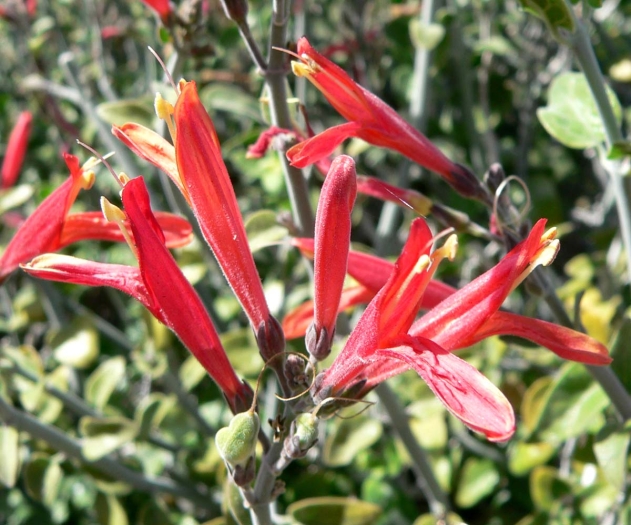Chuparosa
(Justicia californica)
Chuparosa (Justicia californica)
/
/

Stan Shebs
CC BY-SA 3.0
Image By:
Stan Shebs
Recorded By:
Copyright:
CC BY-SA 3.0
Copyright Notice:
Photo by: Stan Shebs | License Type: CC BY-SA 3.0 | License URL: https://creativecommons.org/licenses/by-sa/3.0 | Uploader: Stan Shebs | Publisher: Wikimedia Commons | Title: Justicia_californica_3.jpg | Notes: {{Information |Description={{en|1=''[[Kalanchoe beharensis]]'' San Diego Zoo, California, USA. Identified by sign.}} |Source=Own work by uploader |Author=[[User:Stickpen|Stickpen]] |Date=June 11, 2009 |Permission=released to public domain |other_ve |





















































Estimated Native Range
Summary
Justicia californica, commonly known as chuparosa or hummingbird bush, is a deciduous shrub native to the Sonoran and Mojave Deserts of southern California, Arizona, and northern Mexico. It typically grows to a height and width of 3-4 feet (0.9-1.2 meters). Chuparosa is adapted to arid environments, thriving in sandy or rocky terrain on the desert floor. It is one of the northernmost species of the mostly tropical genus Justicia.
The plant’s form is a low, spreading bush that, for a brief period, bears succulent leaves which it sheds in response to drought. Chuparosa is notable for its tubular flowers that bloom in bright to deep red or sometimes yellow, appearing from late winter to early spring. The flowers are particularly showy, with a wide lower lip that opens to reveal the interior, and they are a significant nectar source for hummingbirds. The plant’s ability to attract wildlife, especially birds, is a key benefit in cultivation. Chuparosa is often used in xeriscaping and as an ornamental in desert gardens due to its vibrant flowers and low water requirements. It thrives in full sun and requires well-drained soil, tolerating poor soil conditions. While it is drought-tolerant, occasional watering during extremely dry periods can promote flowering. There are no significant disease problems, but it may not tolerate freezing temperatures. Gardeners should be aware that Justicia californica can spread readily by seed if conditions are favorable.CC BY-SA 4.0
The plant’s form is a low, spreading bush that, for a brief period, bears succulent leaves which it sheds in response to drought. Chuparosa is notable for its tubular flowers that bloom in bright to deep red or sometimes yellow, appearing from late winter to early spring. The flowers are particularly showy, with a wide lower lip that opens to reveal the interior, and they are a significant nectar source for hummingbirds. The plant’s ability to attract wildlife, especially birds, is a key benefit in cultivation. Chuparosa is often used in xeriscaping and as an ornamental in desert gardens due to its vibrant flowers and low water requirements. It thrives in full sun and requires well-drained soil, tolerating poor soil conditions. While it is drought-tolerant, occasional watering during extremely dry periods can promote flowering. There are no significant disease problems, but it may not tolerate freezing temperatures. Gardeners should be aware that Justicia californica can spread readily by seed if conditions are favorable.CC BY-SA 4.0
Plant Description
- Plant Type: Shrub
- Height: 3-4 feet
- Width: 3-4 feet
- Growth Rate: Rapid
- Flower Color: Orange, Red
- Flowering Season: Spring
- Leaf Retention: Semi-Deciduous
Growth Requirements
- Sun: Full Sun
- Water: Low
- Drainage: Fast
Common Uses
Bee Garden, Bird Garden, Butterfly Garden, Deer Resistant, Drought Tolerant, Hummingbird Garden, Low Maintenance, Showy Flowers, Street Planting
Natural Habitat
Sonoran and Mojave Deserts
Other Names
Common Names: Chuparosa-Honeysuckle, Beloperone, Hummingbird Bush
Scientific Names: , Justicia californica, Beloperone californica, Sericographis californica, Jacobinia californica,
GBIF Accepted Name: Justicia californica (Benth.) D.N.Gibson